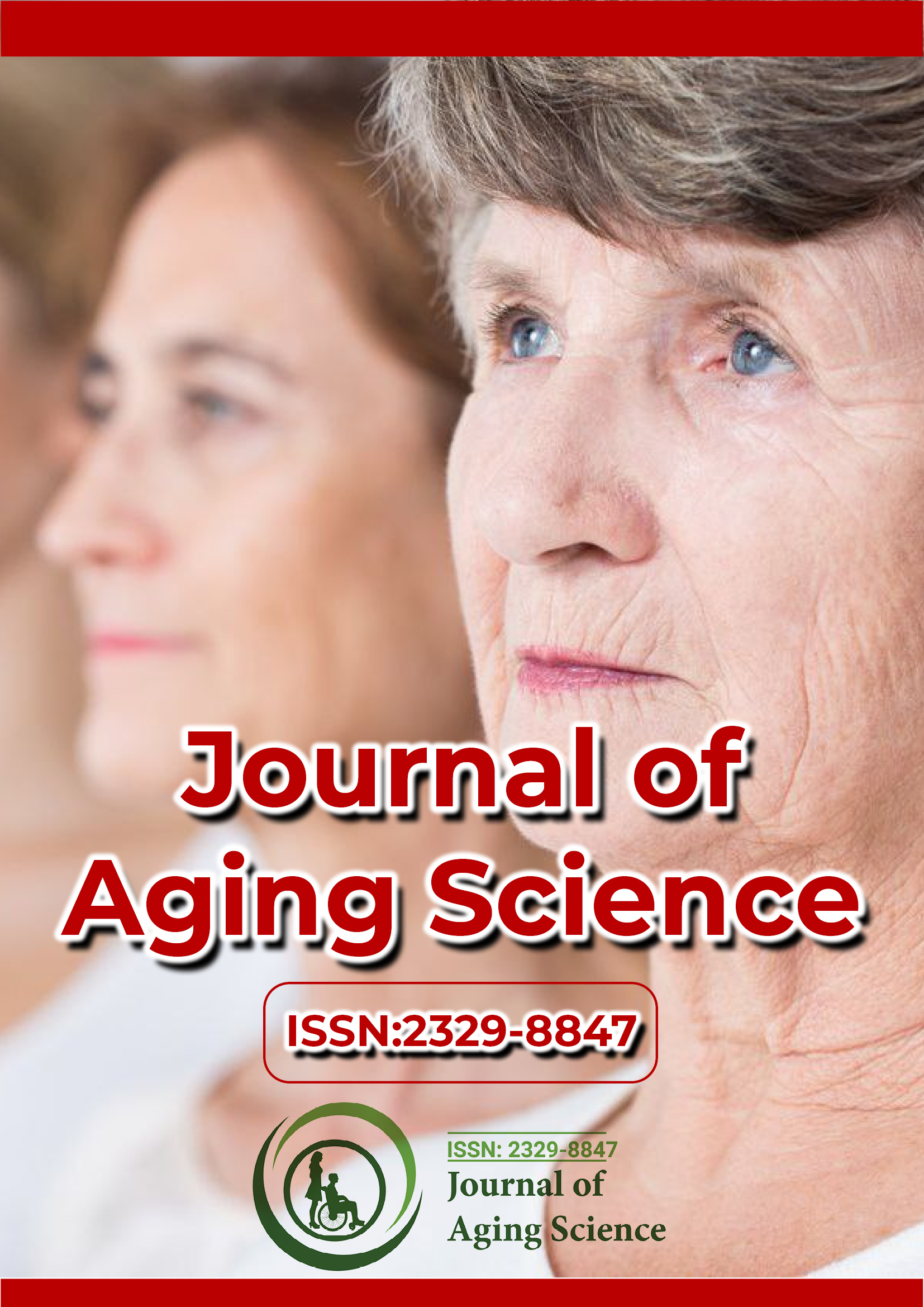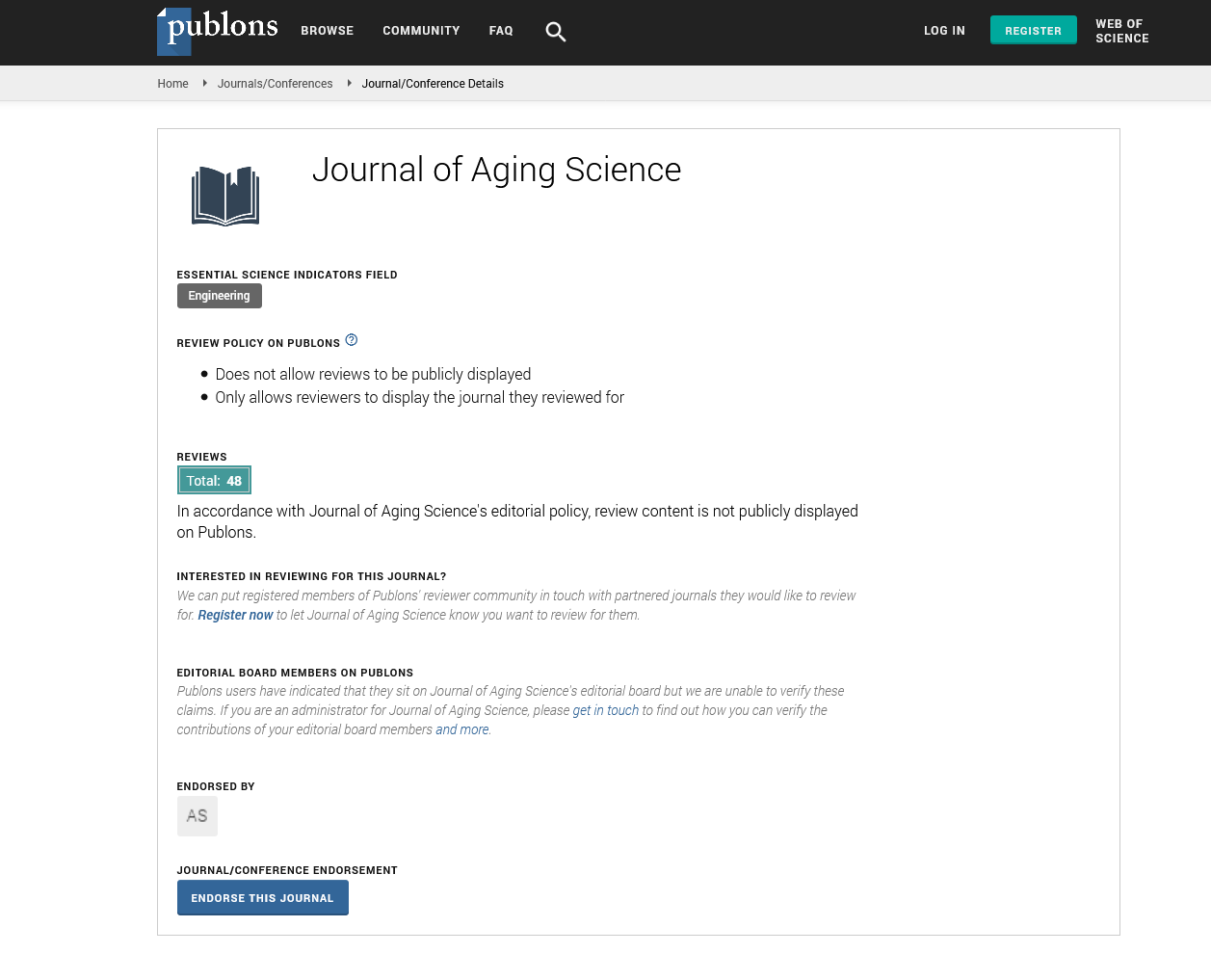Indexed In
- Open J Gate
- Academic Keys
- JournalTOCs
- ResearchBible
- RefSeek
- Hamdard University
- EBSCO A-Z
- OCLC- WorldCat
- Publons
- Geneva Foundation for Medical Education and Research
- Euro Pub
- Google Scholar
Useful Links
Share This Page
Journal Flyer

Open Access Journals
- Agri and Aquaculture
- Biochemistry
- Bioinformatics & Systems Biology
- Business & Management
- Chemistry
- Clinical Sciences
- Engineering
- Food & Nutrition
- General Science
- Genetics & Molecular Biology
- Immunology & Microbiology
- Medical Sciences
- Neuroscience & Psychology
- Nursing & Health Care
- Pharmaceutical Sciences
Opinion Article - (2025) Volume 13, Issue 3
Physical Activity and Aging Biology: Mechanistic Insights into Mobility, Muscle Health and Longevity
Richard Henley*Received: 30-Jun-2025, Manuscript No. JASC-25-29561; Editor assigned: 03-Jul-2025, Pre QC No. JASC-25-29561 (PQ); Reviewed: 17-Jul-2025, QC No. JASC-25-29561; Revised: 24-Jul-2025, Manuscript No. JASC-25-29561 (R); Published: 31-Jul-2025, DOI: 10.35248/2329-8847.25.13.423
Description
Aging is often associated with declines in physical strength, endurance and overall health. However, research consistently demonstrates that physical activity plays a significant role in slowing these changes, improving quality of life and extending healthspan. Far beyond maintaining muscle mass and flexibility, exercise influences nearly every physiological system, from cardiovascular health to brain function, immune defense and cellular aging processes.
One of the most direct impacts of physical activity is seen in the musculoskeletal system. With aging, sarcopenia loss of skeletal muscle mass and function becomes a common concern, often leading to frailty and increased risk of falls. Regular resistance training stimulates muscle protein synthesis, counters muscle atrophy and enhances balance and coordination. Additionally, weight-bearing exercises improve bone density, reducing the risk of osteoporosis and fractures that often accompany advanced age.
The cardiovascular system also benefits greatly from consistent activity. Aging naturally leads to stiffening of blood vessels, reduced elasticity and a decline in cardiac output. Aerobic exercise such as walking, swimming, or cycling helps maintain vascular flexibility, lowers blood pressure and enhances circulation. Improved blood flow ensures adequate oxygen and nutrient delivery to tissues, supporting longevity and reducing risks of heart disease, stroke and other age-related conditions.
Physical activity influences metabolic health by improving insulin sensitivity and regulating glucose metabolism. Aging is often associated with increased fat accumulation, insulin resistance and a higher risk of type 2 diabetes. Exercise reduces visceral fat, increases energy expenditure and supports lipid balance, contributing to healthier body composition. Regular activity also helps regulate hormones involved in appetite, stress and metabolism, providing additional protection against metabolic decline.
At the cellular level, exercise has profound effects on mitochondrial health. Aging mitochondria show reduced efficiency, leading to energy deficits and higher oxidative stress. Physical activity stimulates mitochondrial biogenesis, improving both the number and function of these essential organelles. This not only boosts energy availability but also enhances resilience against oxidative damage, thereby slowing cellular aging.
Telomere biology provides another link between exercise and longevity. Telomeres, protective caps at the ends of chromosomes, shorten with each cell division, serving as markers of biological aging. Studies suggest that individuals with active lifestyles tend to maintain longer telomeres compared to sedentary counterparts, reflecting slower cellular aging and reduced disease risk.
Exercise also plays a key role in regulating inflammation. With age, many individuals develop chronic low-grade inflammation, often referred to as “inflammaging” which contributes to conditions such as arthritis, cardiovascular disease and neurodegeneration. Physical activity reduces inflammatory cytokines while enhancing production of anti-inflammatory mediators. This rebalancing of immune function helps preserve tissue health and protects against age-related disease progression.
The immune system itself is strengthened through regular activity. Aging weakens immune defense, making individuals more susceptible to infections and slower recovery. Moderate exercise enhances immune surveillance, improves lymphocyte activity and boosts the circulation of immune cells. Importantly, exercise can help counter immunosenescence, the age-related decline in immune function, thereby supporting resilience in older populations.
The nervous system also benefits from physical activity. Exercise enhances cognitive function by increasing blood flow to the brain, stimulating neurogenesis in the hippocampus and promoting release of growth factors such as Brain-Derived Neurotrophic Factor (BDNF). These changes support memory, learning and overall mental agility. Physical activity has been linked to lower risks of dementia, Alzheimer’s disease and depression, highlighting its role in preserving both neurological and psychological well-being.
From a psychological perspective, regular exercise reduces stress and improves mood through endorphin release and regulation of neurotransmitters such as serotonin and dopamine. Older adults who engage in physical activity often report better emotional stability, reduced anxiety and enhanced social engagement factors that collectively contribute to healthier aging.
Different types of physical activity provide distinct benefits. Aerobic exercise improves cardiovascular endurance and metabolic function. Resistance training supports muscular strength, bone density and mobility. Flexibility exercises, including yoga and stretching, maintain joint health and prevent stiffness, while balance training reduces fall risk, which is a major concern in older adults. A comprehensive fitness routine incorporating all these elements is most effective for promoting healthy aging.
Emerging research also examines how exercise interacts with epigenetic modifications. Physical activity can influence DNA methylation and histone modifications, altering gene expression patterns in ways that protect against age-related decline. This suggests that exercise not only improves immediate physical and mental health but may also induce long-lasting molecular changes that slow biological aging.
In terms of public health, promoting physical activity among older populations presents challenges. Sedentary lifestyles, chronic disease and mobility limitations often discourage regular exercise. However, tailored interventions such as low-impact aerobics, chair exercises, or community-based walking programs can make activity more accessible. Social environments, group activities and supportive infrastructure further encourage sustained participation.
Conclusion
Physical activity is a powerful determinant of how well individuals age. It influences nearly every aspect of human biology, from muscles and bones to the cardiovascular, metabolic, immune and nervous systems. At the molecular level, exercise enhances mitochondrial function, preserves telomeres, reduces inflammation and modulates epigenetic patterns linked to longevity. The benefits of physical activity extend beyond biological resilience to encompass psychological well-being, social connectedness and independence in later years. By integrating aerobic, resistance, flexibility and balance exercises into daily routines, older adults can maintain physical strength, cognitive vitality and emotional stability. Ultimately, exercise is not merely a lifestyle choice but a biological necessity for aging well. Promoting accessible and sustainable activity throughout life represents one of the most effective strategies for extending healthspan, ensuring that added years of life are lived with strength, clarity and independence.
Citation: Henley R (2025). Physical Activity and Aging Biology: Mechanistic Insights into Mobility, Muscle Health and Longevity. J Aging Sci. 13:423.
Copyright: © 2025 Henley R. This is an open-access article distributed under the terms of the Creative Commons Attribution License, which permits unrestricted use, distribution and reproduction in any medium, provided the original author and source are credited.

